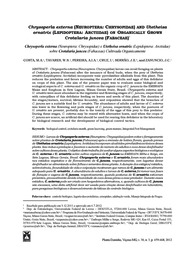Chrysoperla externa (Neuroptera: Chrysopidae) and Utetheisa ornatrix (Lepidoptera: arctiidae) on organically grown Crotalaria juncea (Fabaceae).
Chrysoperla externa (Neuroptera: Chrysopidae) and Utetheisa ornatrix (Lepidoptera: arctiidae) on organically grown Crotalaria juncea (Fabaceae).
Author(s): COSTA, M. A.; TAVARES, W. S.; PEREIRA, A. I. A.; CRUZ, I.; SERRÃO, J. E.; ZANUNCIO, J. C.
Summary: Chrysoperla externa (Neuroptera: Chrysopidae) larvae can avoid foraging on plants of Crotalaria juncea (Fabaceae) after the issuance of floral buds, when the prey of Utetheisa ornatrix (Lepidoptera: Arctiidae) incorporate toxic pyrrolizidine alkaloids from this plant. This reduces the predation and favors increasing the number of adults and eggs of this defoliator on crops of this plant. The aim of the present paper was to evaluate some biological and ecological aspects of C. externa and U. ornatrix on the organic crop of C. juncea in the EMBRAPA Maize and Sorghum in Sete Lagoas, Minas Gerais State, Brazil. Chrysoperla externa and U. ornatrix were more abundant in the vegetative and flowering stages of C. juncea, respectively, with caterpillars of this defoliator feeding on leaves and seeds of this plant. The duration of the stages/instars, survival, lifetime fecundity, and oviposition showed that the branches of C. juncea are a suitable food for U. ornatrix. The abundance of adults and larvae of C. externa was lower in the flowering and pods stages of C. juncea, respectively, when the postures of U. ornatrix are present, probably due to the toxicity of the eggs of this prey to this predator. During these stages, C. externa may be reared with alternative hosts, and when the crops of C. juncea are scarce, an artificial diet should be used for rearing this defoliator in the laboratory for biological research and the development of biological control tactics.
Publication year: 2012
Types of publication: Journal article
Unit: Embrapa Maize & Sorghum
Keywords: Adubação Verde, Controle biológico, Larva, Manejo integrado de praga
Observation
Some of Embrapa's publications are published as ePub files. To read them, use or download one of the following free software options to your computer or mobile device. Android: Google Play Books; IOS: iBooks; Windows and Linux: Calibre.
Access other publications
Access the Agricultural Research Database (BDPA) to consult Embrapa's full library collection and records.
Visit Embrapa Bookstore to purchase books and other publications sold by Embrapa.

